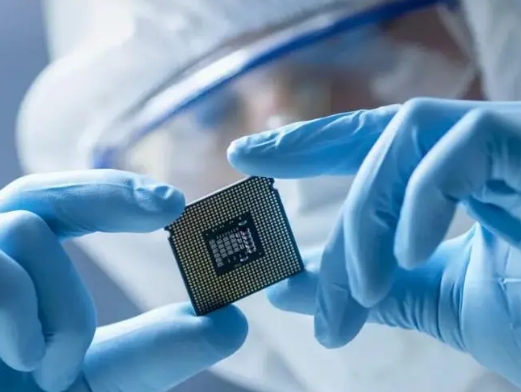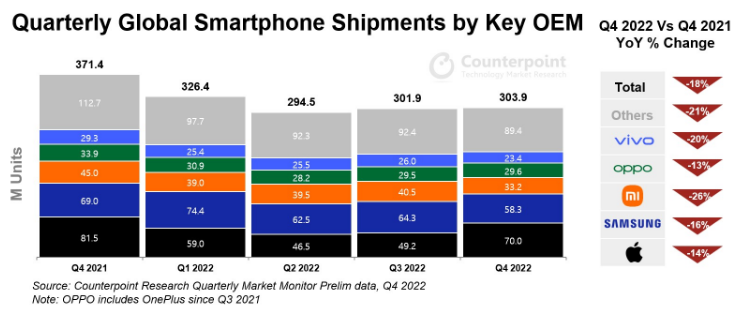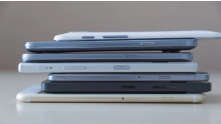Global Smartphone Production Volume to Remain Flat in 4Q18 Due to Sluggish Demand
According to TrendForce’s latest report on this year’s smartphone production, the total volume for 3Q18 grew by 8% from 2Q18 to around 380 million. The growth was attributed to a gradual recovery of demand in 2Q18 and the stock-up of inventories related to releases of new devices and holiday sales events. Although the latest products from Apple and Huawei continue to generate demand in the smartphone market, the sales of new iPhone XR/XS/XS Max turned out to fall short of expectation, resulting in lower shipments of iPhones. Therefore, DRAMeXchange estimates that the total production volume for 4Q18 will be roughly similar to that of 3Q18, coming to around 380 million units.

Since the general development of the smartphone market has reached the mature stage, and smartphone brands are struggling to differentiate their new products, many of which lack breakthrough features to stimulate purchases. Thus, consumers are less active than before with respect to replacing their existing devices. For many smartphone makers, they have to work harder to highlight their brand values in the midst of the fierce competition. Some of them are committing more resources in developing their high-end models, while others are raising hardware specifications to show that they are offering greater value and better performance for the cost. Nevertheless, these efforts also put the squeeze on their profit margins.
There are also other variables that will make the maintenance of profitability very challenging. In addition to the fluctuations in exchange rates and rising costs of components, the uncertainties produced by the ongoing US-China trade dispute are also going to impact their operation. At the same time, major smartphone brands will continue to enlarge their market shares at the expense of the smaller brands.
Apple will compete with Samsung for the top position in the production volume ranking for 4Q18
Among the world’s top six smartphone brands by production volume, Samsung again topped the ranking in 3Q18 with a quarterly total of 74.5 million units, which also amounted to a market share of almost 20%. While Samsung grew its sales by releasing its flagship Galaxy Note 9 ahead of schedule, the device was not a significant upgrade from last year’s Note 8 and made limited contribution to the brand’s total volume in 3Q18. The Galaxy J series, on the other hand, was still instrumental in sustaining the brand’s overall production. In this fourth quarter, Samsung has been promoting the Galaxy A devices, emphasizing their improved cost-to-performance ratios and their cameras (i.e. the triple camera on A7 and the quad rear camera on A9). Samsung’s total production volume in 4Q18 is estimated to reach around 75 million units, which will be similar to the 3Q18 result and in line with the company’s target for the period.
The strong channel demand for its latest devices caused Huawei’s total smartphone production volume in 3Q18 to surge by 44% YoY to a new high of 55.5 million units. Huawei is currently the world’s second largest smartphone brand, surpassing Apple in volume for two consecutive quarters. Huawei’s in-house R&D capabilities and extensive product lines across all market segments have benefitted its expansions in the overseas markets during the recent years. Huawei also continues to innovate on hardware and manufacture its own mobile SoCs via its subsidiary HiSilicon.
Going forward, Huawei will keep expanding its global presence. Driven by the sales of its latest devices, Huawei’s total production volume in the 4Q18 is estimated to be on the similar level as the result of 3Q18. And the brand’s total volume for the whole year of 2018 is currently projected to hit 200 million units, which would meet the company’s target. However, there are now warnings that inventories across channels are going to be too high. The future development of this situation warrants attention as it may affect Huawei’s smartphone production in 4Q18 and 1Q19.
Apple was behind Huawei for the second consecutive quarter as the world’s third largest brand in 3Q18, with its iPhone production volume for the period totaling 47.1 million units. Apple’s iPhone devices for this year again intended to push the upper limit of the acceptable price range for high-end smartphones. And consumers appear to be less willing to pay for the two new AMOLED models – iPhone XS and XS Max, which are priced too high to be accepted. The economically priced LCD model, iPhone XR, may take over as the sales driver, but the ramp-up of its production had been scheduled to take place in 4Q18. Furthermore, factors such as the US-China trade dispute and the appreciation of the US dollar have been constraining iPhone sales outside the US. Consequently, iPhone XR did not contribute significantly to the iPhone production in 3Q18.
Looking ahead, Apple can further lower the prices of its older iPhone models to spur sales. Also, 4Q18 is expected to be the year’s peak iPhone production period, as Apple has scheduled the ramp-up of its latest models during this time. Thus, the total iPhone production volume in 4Q18 is estimated to reach around 76 million units, which would allow Apple to surpass Huawei and compete with Samsung for the top position in the ranking.
Xiaomi’s total smartphone production volume in 3Q18 came to 31.7 million units. This result was relatively on par with that of 2Q18, and the brand this time did not register a double-digit YoY growth as before. The flat growth can be attributed to the slowdown in demand in China and India, which are Xiaomi’s two largest smartphone markets. And because of this, Xiaomi has also scaled back its stock-up demand so as to prevent its inventory of all devices from becoming too high and put pressure on the company’s cash flow. Xiaomi’s total smartphone production volume in 4Q18 is estimated to be within 30 million units, and its total volume for the whole year is currently projected to come to around 120 million units.
Regarding its sales strategy, Xiaomi still prioritizes volume over margin. Besides tightly controlling the costs of key components, Xiaomi is going to localize production in the overseas markets in order to further lower the assembly cost and evade tariff barriers. For instance, the company is making procurements and building manufacturing facilities in India. The drawback of maintaining a very thin profit margin, however, is that external factors related to the wider economic environment can cause sudden increases in production cost and adversely affect the company’s entire operation.
OPPO’s and Vivo’s total smartphone volumes in 3Q18 both topped 30 million units, registering slight increases from their respective results for 2Q18. The two Chinese brands were able to raise their production on the back of the new flagship releases and the stock-up demand from the retail channels. The strategy of OPPO and Vivo during the recent years have been to focus on improving hardware, especially memory specifications, so as to gain recognition in the market. OPPO and Vivo currently depend on China and Southeast Asia for much of their sales. However, these markets are experiencing a slowdown in demand and have limited room for further growth. This, along with the longer replacement cycle, will raise challenges for the two brands as they try to maintain their production levels in the future. OPPO’s total volume is projected to fall by 23% QoQ in 4Q18 to 24.5 million units, while Vivo’s total volume is projected to fall by 20% QoQ in 4Q18 to 24.1 million units.
在线留言询价
- 一周热料
- 紧缺物料秒杀
| 型号 | 品牌 | 询价 |
|---|---|---|
| CDZVT2R20B | ROHM Semiconductor | |
| TL431ACLPR | Texas Instruments | |
| BD71847AMWV-E2 | ROHM Semiconductor | |
| RB751G-40T2R | ROHM Semiconductor | |
| MC33074DR2G | onsemi |
| 型号 | 品牌 | 抢购 |
|---|---|---|
| STM32F429IGT6 | STMicroelectronics | |
| TPS63050YFFR | Texas Instruments | |
| ESR03EZPJ151 | ROHM Semiconductor | |
| IPZ40N04S5L4R8ATMA1 | Infineon Technologies | |
| BU33JA2MNVX-CTL | ROHM Semiconductor | |
| BP3621 | ROHM Semiconductor |
AMEYA360公众号二维码
识别二维码,即可关注




























